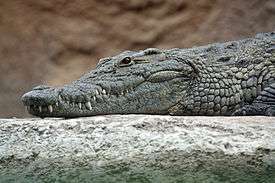Diapsid
| Diapsid reptiles Temporal range: Pennsylvanian–Present, 307–0 Ma | |
|---|---|
 | |
| Life restoration of an araeoscelidian (Petrolacosaurus kansensis) | |
 | |
| Nile crocodile (Crocodylus niloticus) | |
| Scientific classification | |
| Kingdom: | Animalia |
| Phylum: | Chordata |
| Class: | Reptilia |
| Clade: | Romeriida |
| Clade: | Diapsida Osborn, 1903 |
| Subgroups | |
Diapsids ("two arches") are a group of amniote tetrapods that developed two holes (temporal fenestra) in each side of their skulls about 300 million years ago during the late Carboniferous period.[1] The diapsids are extremely diverse, and include all crocodiles, lizards, snakes, tuatara, turtles,[2] and dinosaurs (both avian and non-avian). Although some diapsids have lost either one hole (lizards), or both holes (snakes), or have a heavily restructured skull (modern birds), they are still classified as diapsids based on their ancestry. At least 7,925 species of diapsid reptiles[3] exist in environments around the world today (nearly 18,000 when birds are included).
Characteristics

The name Diapsida means "two arches", and diapsids are traditionally classified based on their two ancestral skull openings (temporal fenestrae) posteriorly above and below the eye. This arrangement allows for the attachment of larger, stronger jaw muscles, and enables the jaw to open more widely. A more obscure ancestral characteristic is a relatively long lower arm bone (the radius) compared to the upper arm bone (humerus).
Classification
Diapsids were originally classified as one of four subclasses of the class Reptilia, all of which were based on the number and arrangement of openings in the skull. The other three subclasses were Synapsida (one opening low on the skull, for the "mammal-like reptiles"), Anapsida (no skull opening, including turtles and their relatives), and Euryapsida (one opening high on the skull, including many prehistoric marine reptiles). With the advent of phylogenetic nomenclature, this system of classification was heavily modified. Today, the synapsids are often not considered true reptiles, while Euryapsida were found to be an unnatural assemblage of diapsids that had lost one of their skull openings. Genetic studies have shown that this is also the case in turtles, which are actually heavily modified diapsids. In phylogenetic systems, birds (descendants of traditional diapsid reptiles) are also considered to be members of this group.
Some modern studies of reptile relationships have preferred to use the name "diapsid" to refer to the crown group of all modern diapsid reptiles but not their extinct relatives. However, many researchers have also favored a more traditional definition that includes the prehistoric araeoscelidians. In 1991, Laurin defined Diapsida as a clade, "the most recent common ancestor of araeoscelidians, lepidosaurs, and archosaurs, and all its descendants."[4]
Relationships
Below is a cladogram showing the relations of the major groups of diapsids.
Cladogram after Bickelmann et al., 2009[5] and Reisz et al., 2011:[6]
| Diapsida |
| ||||||||||||||||||||||||||||||||||||||||||||||||||||||||||||||||||||||||||||||
| |
See also
References
- ↑ "Those diverse diapsids".
- ↑ Zoology (Jena). 2016 Jun;119(3):159-61. doi: 10.1016/j.zool.2016.01.004. Epub 2016 Feb 1
- ↑ http://journals.plos.org/plosone/article?id=10.1371/journal.pone.0118199
- ↑ Benton, M. J., Donoghue, P. C., Asher, R. J., Friedman, M., Near, T. J., & Vinther, J. (2015). "Constraints on the timescale of animal evolutionary history." Palaeontologia Electronica, 18.1.1FC; 1-106; palaeo-electronica.org/content/fc-1
- ↑ Constanze Bickelmann, Johannes Müller and Robert R. Reisz (2009). "The enigmatic diapsid Acerosodontosaurus piveteaui (Reptilia: Neodiapsida) from the Upper Permian of Madagascar and the paraphyly of younginiform reptiles". Canadian Journal of Earth Sciences. 49 (9): 651–661. doi:10.1139/E09-038.
- ↑ Robert R. Reisz, Sean P. Modesto and Diane M. Scott (2011). "A new Early Permian reptile and its significance in early diapsid evolution". Proceedings of the Royal Society B. 278 (1725): 3731–7. doi:10.1098/rspb.2011.0439. PMC 3203498
 . PMID 21525061.
. PMID 21525061.
External links
| Wikispecies has information related to: Diapsid |
- Diapsida. Michel Laurin and Jacques A. Gauthier. Tree of Life Web Project. June 22, 2000.
- Diapsida Cladogram at Mikko's Phylogeny Archive